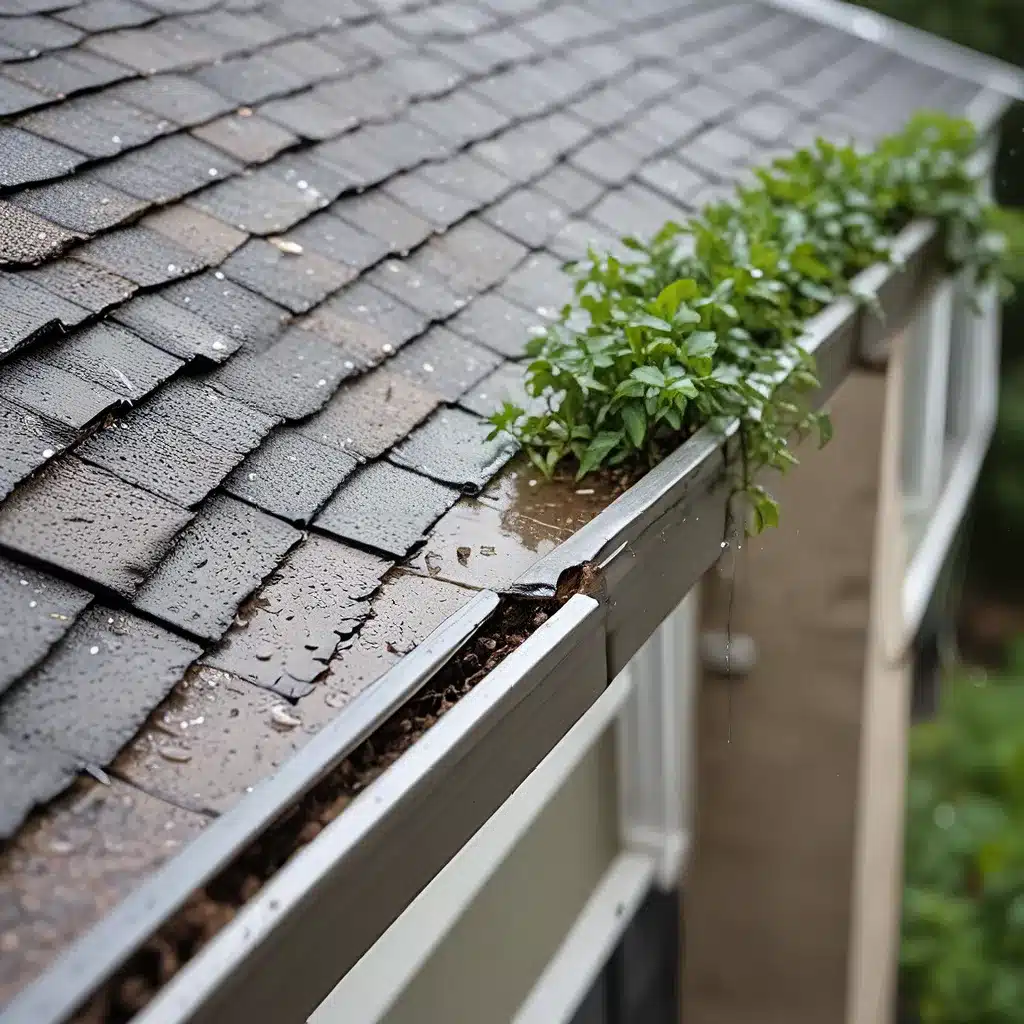
As a homeowner, I know all too well the frustrations that come with heavy downpours. It’s like Mother Nature has a personal vendetta against my roof and gutters! One day, I was standing on my porch, watching in dismay as the water from my second-floor roof raced down to the first-floor roof, only to leap right over the gutter. It was like a miniature Niagara Falls, just waiting to wreak havoc on my siding and foundation.
Understanding the Problem
Now, I’m no stranger to the occasional gutter overflow, but this was something else entirely. Turns out, it’s a common issue that many homeowners face, especially those of us who live in regions with heavy rainfall and snowfall, like Michigan. Apparently, it’s all about that good old-fashioned physics – when you concentrate a large volume of water from an upper-level roof into a single downspout, the sheer force of it can cause the water to literally “jump” over the gutter below.
As I delved deeper into this problem, I discovered that this kind of gutter overload can lead to some serious consequences. The water rushing over the roof can damage those precious shingles, causing them to wear down prematurely. And if that water manages to seep into the siding or foundation, well, let’s just say you’re looking at a whole host of other headaches down the line.
Exploring Solutions
Now, I’m not one to just sit back and let Mother Nature have her way. I started scouring the internet, searching for ways to tame this watery beast. One solution I came across was the idea of using a “gusher guard” – essentially a device that helps redirect the water flow. But then I read a cautionary tale about how these contraptions can actually end up causing more harm than good, especially when you factor in the snow and ice that come with a Michigan winter.
Another suggestion was to extend the second-floor downspout, so the water would dump directly onto the first-floor roof, rather than cascading over the edge. But as I envisioned that janky-looking setup, I just couldn’t bring myself to do it. I mean, let’s be real, who wants their house to look like a DIY disaster zone?
Finding the Right Balance
After much research and head-scratching, I think I’ve finally landed on a solution that’s both effective and, dare I say, kind of stylish. The key, it seems, is finding a way to spread out the water flow so it doesn’t all just come barreling down in one concentrated stream.
One idea I stumbled upon was to install a 90-degree elbow at the end of the second-floor downspout, which would redirect the water to flow across the first-floor roof rather than straight down. This helps distribute the load more evenly and reduces the risk of the water “jumping” the gutter.
Another option is to add a secondary downspout that runs parallel to the first-floor roof, dumping the water directly into the ground rather than relying on the gutter system to handle it all. This way, you’re essentially creating a separate drainage system to take the pressure off the gutters.
And if you really want to get fancy, you could look into something called a “spreader” – a specialized gutter attachment that helps disperse the water flow across a wider area. These babies are apparently a standard solution in places like New Zealand, where heavy rainfall is a way of life.
Balancing Aesthetics and Function
Now, I know what you’re thinking – “But won’t all these extra pipes and attachments make my house look like a hot mess?” And trust me, I hear you. That was one of my biggest concerns too. But the truth is, with a little creative thinking and some strategic placement, you can actually incorporate these solutions in a way that’s both functional and aesthetically pleasing.
For example, you could paint the additional downspouts to match the color of your siding, or tuck them neatly behind landscaping. And if you go the “spreader” route, you can choose one that’s made of materials that complement your home’s style, like copper or decorative metal.
At the end of the day, it’s all about finding the right balance between protecting your home and maintaining its curb appeal. Because let’s be real, who wants a roof that looks like it’s been through a war zone, even if it is staying dry?
The Importance of Proper Maintenance
Of course, no matter what solutions you implement, it’s crucial to stay on top of regular gutter and roof maintenance. Clogged gutters can quickly turn a minor issue into a major headache, and neglected shingles can lead to leaks and other structural problems.
That’s why I make it a point to clean my gutters at least twice a year, and I keep a close eye on my roof for any signs of wear and tear. It may not be the most glamorous task, but it’s a small price to pay to keep my home safe and sound.
And let’s not forget about the importance of proper drainage around the foundation. If all that water from the gutters has nowhere to go, it can seep into the basement or crawl space, causing all sorts of unwanted problems. That’s where a well-designed French drain or other drainage system can be a real lifesaver.
Embracing the Challenge
Look, I get it – dealing with heavy rainfall and its impact on your home can be a real pain in the you-know-what. But the way I see it, it’s all just part of the homeowner’s journey. Every challenge is an opportunity to learn, grow, and find creative solutions.
And who knows, maybe one day I’ll be the one giving other homeowners advice on how to tame their own water-related woes. Until then, I’ll keep tinkering, experimenting, and keeping a close eye on those gutters. After all, it’s all about staying one step ahead of Mother Nature, right?